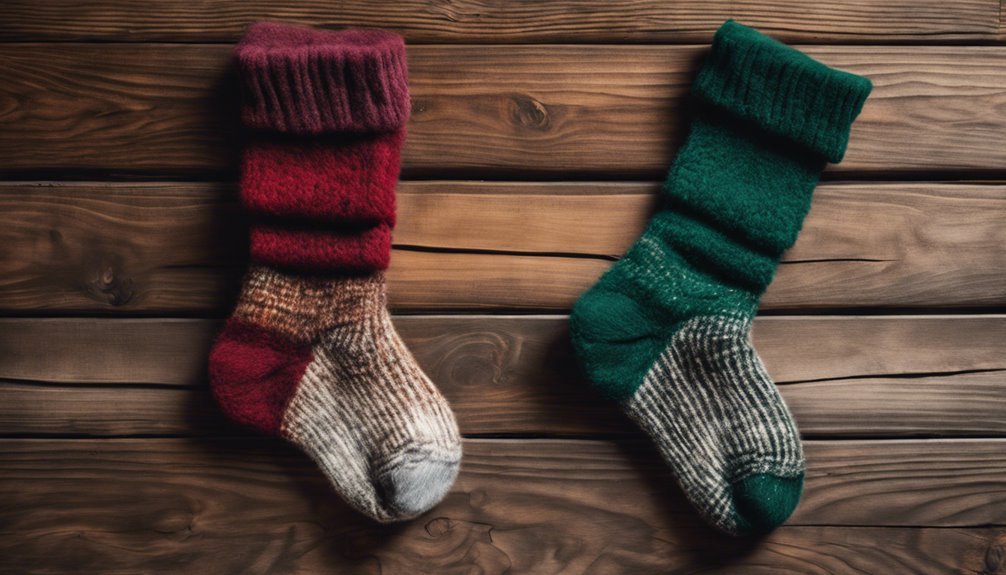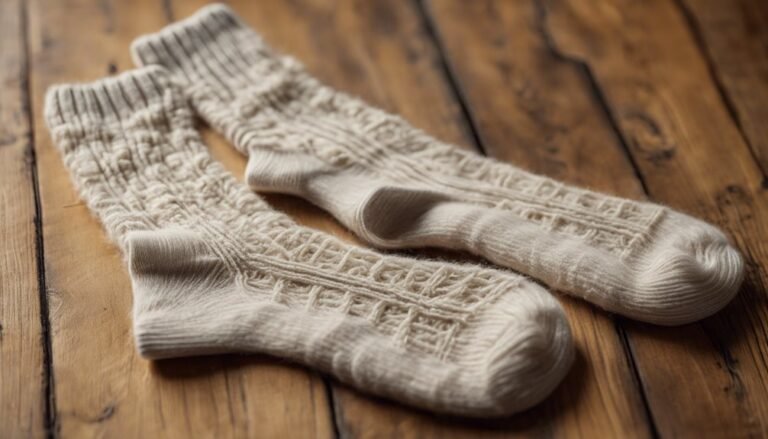Wool Socks vs. Fleece Socks: Which Is Warmer for Winter?
When deciding on warmth for winter, wool socks outperform fleece options due to their superior insulation and moisture management. Wool's natural fibers trap heat effectively while allowing moisture to escape, keeping your feet dry and warm. Fleece socks provide decent warmth but can lose their insulating properties when damp. If you seek the best performance in cold conditions, wool is your best bet for comfort and thermal retention. Explore more details on how to choose the right socks for your activities.
Understanding Wool Socks
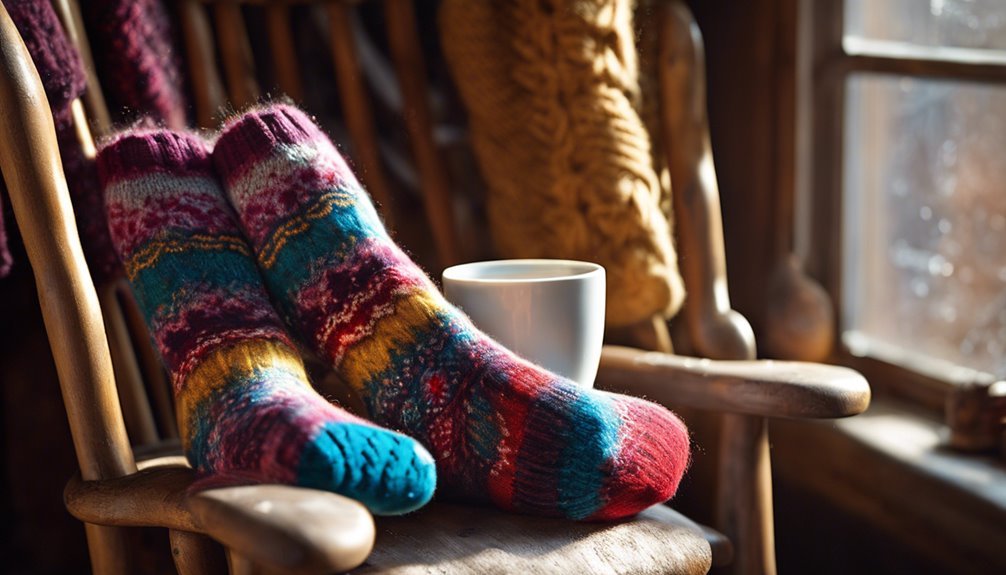
When you think about warmth and comfort in cold weather, wool socks often come to mind as an ideal choice. Made from natural fibers, wool is a remarkable sock material known for its excellent temperature regulation. It traps air, creating insulation while allowing moisture to escape, keeping your feet dry and warm. This unique property helps prevent overheating, making wool socks suitable for various activities, from lounging at home to outdoor adventures. Wool's natural elasticity guarantees a snug fit, reducing the risk of blisters. Additionally, its antimicrobial properties help combat odor, enhancing your overall experience. Understanding these attributes highlights why wool socks are a preferred option for those seeking both comfort and functionality during chilly conditions.
Advantages of Wool Socks
When it comes to wool socks, their moisture-wicking properties really set them apart, keeping your feet dry and comfortable. Additionally, natural insulation benefits mean you'll stay warm in cold conditions without overheating. Plus, their odor resistance factor helps maintain freshness, making them a smart choice for extended wear.
Moisture-Wicking Properties
Wool socks stand out for their exceptional moisture-wicking properties, making them a top choice for anyone seeking comfort during outdoor activities. Unlike other materials, wool fibers can pull moisture away from your skin, allowing for superior moisture absorption. This helps prevent that clammy feeling often associated with sweat build-up. By effectively managing moisture, wool socks also play an essential role in temperature regulation, keeping your feet warm without overheating. You'll appreciate how they maintain a balanced microclimate, even in fluctuating conditions. So, whether you're hiking, skiing, or just enjoying a winter walk, wool socks guarantee your feet stay dry and comfortable, allowing you the freedom to focus on your adventure without distraction.
Natural Insulation Benefits
Though many materials claim to provide warmth, wool truly excels in its natural insulation benefits. Made from natural fibers, wool offers superior thermal regulation, keeping your feet warm without overheating. The unique structure of wool fibers traps air, creating an insulating layer that adapts to your body temperature. This means that whether you're hiking in the snow or lounging at home, wool socks maintain a comfortable climate for your feet. Additionally, wool's moisture-wicking properties help regulate humidity, further enhancing your overall comfort. When you're seeking freedom to enjoy winter activities without worrying about cold feet, wool socks stand out as a reliable choice, providing warmth and adaptability in various conditions. Embrace the natural benefits of wool for your winter adventures.
Odor Resistance Factor
While some materials may trap odors, wool socks stand out for their natural odor resistance, making them an excellent choice for active lifestyles. This unique property stems from wool's material composition, which includes lanolin, a natural wax that helps repel moisture and inhibit bacterial growth—two primary culprits behind unpleasant smells. As you wear wool socks, they manage to absorb moisture without feeling wet, keeping your feet dry and minimizing odor. Unlike synthetic alternatives, which can retain odors even after washing, wool's inherent qualities guarantee that you can enjoy multiple wears without the need for frequent laundering. For those who value freedom in movement and comfort, choosing odor-resistant wool socks is a smart, practical decision.
Disadvantages of Wool Socks
Although many appreciate the warmth and moisture-wicking properties of wool socks, they do come with some notable disadvantages. One significant issue is the itchiness factor; not everyone can tolerate the texture of wool against their skin. Additionally, wool socks can be pricier compared to synthetic options, which may deter budget-conscious consumers.
| Disadvantages | Description |
|---|---|
| Itchiness Factor | Can cause discomfort for sensitive skin |
| Price Comparison | Generally higher cost than fleece socks |
| Care Requirements | Often require hand wash or special care |
| Durability | May wear out faster with heavy use |
| Allergic Reactions | Some individuals may be allergic to wool |
Consider these factors when deciding if wool socks are the right choice for you.
Exploring Fleece Socks
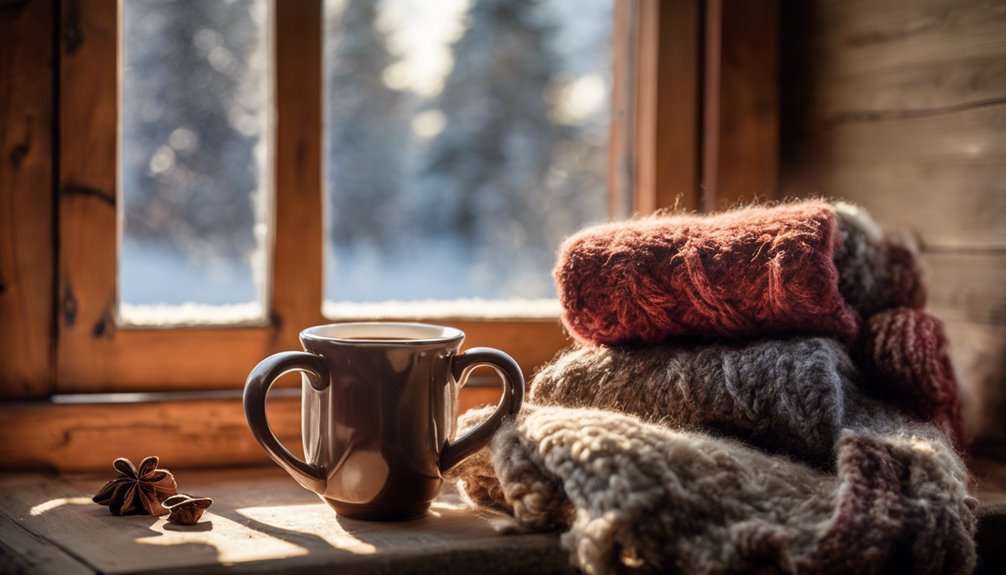
Fleece socks offer impressive insulation properties, making them a popular choice for cold weather. Their moisture-wicking capabilities help keep your feet dry, which is essential for comfort and performance. Plus, the soft texture and fit of fleece socks guarantee they're not only functional but also enjoyable to wear throughout the day.
Insulation Properties of Fleece
When it comes to insulation, fleece socks stand out for their ability to trap warmth without adding excessive bulk. Their unique structure creates air pockets that effectively retain heat, making them a solid choice for cold weather. Plus, fleece breathability guarantees moisture can escape, preventing that clammy feeling during active pursuits. This breathability, combined with fleece durability, means your socks can withstand the rigors of winter adventures while keeping your feet cozy. Whether you're hiking, skiing, or simply enjoying a winter stroll, fleece socks offer an excellent balance of warmth and comfort. By choosing fleece, you're opting for a lightweight yet effective solution that keeps you warm, allowing you to embrace the freedom of outdoor activities without the worry of cold feet.
Moisture-Wicking Capabilities
While you might associate warmth with fleece socks, their moisture-wicking capabilities are equally impressive. Fleece is designed to pull moisture away from your feet, reducing moisture retention and enhancing comfort during winter activities. Here are some key benefits:
- Quick Drying Speed: Fleece dries faster than traditional materials, keeping your feet fresher.
- Breathability: The fabric allows for airflow, preventing sweat buildup.
- Lightweight: Despite excellent moisture management, fleece remains lightweight, so you won't feel weighed down.
- Durability: Fleece socks can withstand multiple washes without losing their moisture-wicking properties.
Comfort and Fit Factors
Choosing the right sock goes beyond just moisture management; comfort and fit play a significant role in your overall experience. When it comes to fleece socks, sizing considerations are essential. A well-fitted sock should hug your foot without restricting circulation. Look for options that offer a snug fit around the arch and heel while allowing some wiggle room in the toe area. This balance guarantees ideal toe comfort, preventing blisters and irritation during long winter outings. Additionally, consider features like cushioning and seamless toes, which enhance comfort further. Remember, the right fleece sock can transform your cold-weather adventures, providing warmth without sacrificing the freedom of movement. Always prioritize fit to enjoy your winter activities to the fullest.
Advantages of Fleece Socks
Although both wool and fleece socks offer warmth, fleece socks come with distinct advantages that make them a popular choice for many. Here are some key benefits you might appreciate:
- Fleece Durability: Fleece socks are designed to withstand wear and tear, making them a reliable option for outdoor activities.
- Fleece Breathability: They allow moisture to escape, keeping your feet dry and comfortable during vigorous movements.
- Lightweight: Fleece socks are generally lighter than wool, offering freedom of movement without sacrificing warmth.
- Quick Drying: When exposed to moisture, fleece dries faster than wool, ensuring you stay warm and cozy in unpredictable conditions.
With these features, fleece socks provide a practical and enjoyable solution for staying warm this winter.
Disadvantages of Fleece Socks
Fleece socks, despite their many benefits, do have several drawbacks that can affect their performance in certain situations. One major issue is fleece breathability; while they provide warmth, they often trap moisture, leading to dampness that could chill your feet. This moisture retention can be uncomfortable during extended wear, especially in active scenarios. Additionally, fleece durability concerns arise as these socks may wear out faster than wool counterparts. Frequent use can lead to pilling or loss of insulation, reducing their overall effectiveness. If you're seeking long-lasting comfort and temperature regulation, it is crucial to weigh these disadvantages against the benefits fleece socks offer. Understanding these factors can help you make a more informed choice for your winter adventures.
Comparing Warmth and Insulation
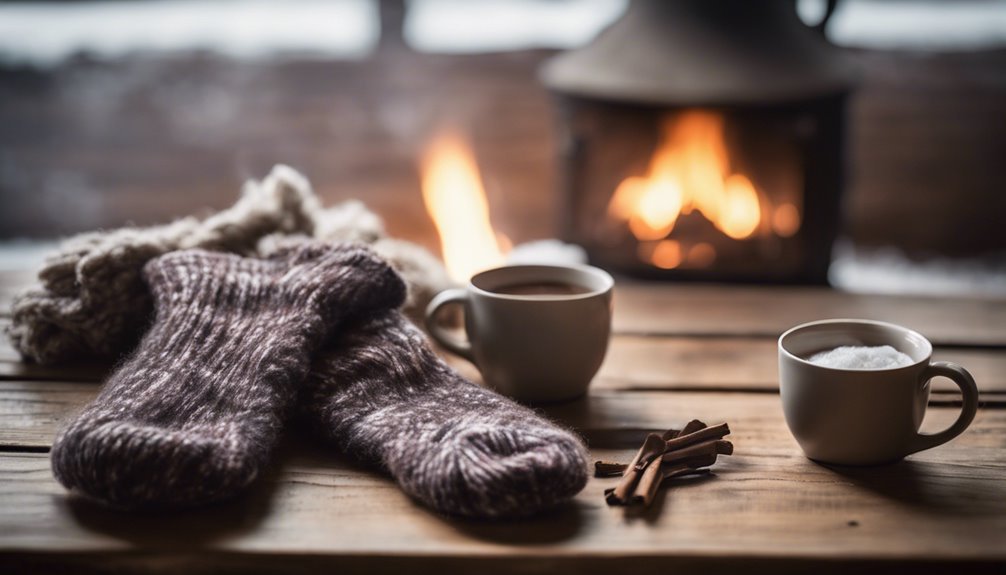
When it comes to warmth and insulation, understanding the differences between wool and fleece socks is essential for making the best choice for your needs. Both materials offer unique benefits for thermal retention and insulation layers, but they perform differently in cold conditions.
- Wool Socks: Known for superior thermal retention, they trap heat even when wet.
- Fleece Socks: Provide decent insulation but may lose warmth in damp conditions.
- Breathability: Wool allows moisture to escape, maintaining insulation layers.
- Durability: Wool tends to withstand wear and tear better, ensuring longevity.
Choosing the right sock can make a huge difference in your winter comfort. Understanding these factors will help you enjoy your winter adventures without worrying about cold feet.
Moisture Management in Wool vs. Fleece
How do wool and fleece socks handle moisture differently? Wool excels in moisture management, absorbing sweat without feeling wet, thanks to its natural moisture retention properties. It allows your feet to breathe, reducing the risk of blisters and odor. Fleece, on the other hand, tends to trap moisture against your skin, leading to dampness and discomfort.
| Feature | Wool Socks |
|---|---|
| Moisture Retention | High |
| Breathability | Excellent |
| Drying Time | Moderate |
| Odor Resistance | Superior |
| Comfort Level | High |
In colder temperatures, these breathability differences can notably impact your comfort. Choosing the right material can make all the difference in your winter activities.
Choosing the Right Sock for Your Activities
Which sock you choose can considerably impact your comfort and performance during various activities. Understanding the right sock materials for your specific activity types is essential. Here's how to pick:
- Hiking: Opt for wool socks; they provide warmth and moisture-wicking properties.
- Running: Fleece socks are lightweight and breathable—perfect for long distances.
- Casual Wear: Either material works, but consider wool for added warmth and durability.
- Cold Weather Sports: Choose thick wool socks for insulation and cushioning.
Frequently Asked Questions
Can I Wear Wool and Fleece Socks Together for Extra Warmth?
Yes, you can wear wool and fleece socks together for extra warmth. Using layering techniques can enhance insulation, but keep in mind sock thickness to avoid discomfort and guarantee proper fit inside your footwear.
How Do Wool and Fleece Socks Perform in Wet Conditions?
When the rain pours, your choice matters. Wool excels in wet performance, wicking moisture away, while fleece clings to dampness. For ideal moisture management, consider layering, ensuring your feet stay cozy and dry, regardless of conditions.
Are There Any Specific Brands Recommended for Winter Socks?
When choosing winter socks, consider brands like Smartwool or Darn Tough, which balance sock thickness and insulation. For brand comparisons, look for materials, durability, and moisture management to guarantee your feet stay warm and comfortable.
How Should I Care for Wool and Fleece Socks?
Imagine your socks are like cherished memories; proper care keeps them vibrant. For sock washing, use gentle cycles and cold water. Store them in a cool, dry place to maintain their softness and longevity.
What Materials Are Used in Blends of Wool and Fleece Socks?
When exploring sock blends, you'll find materials like merino wool, nylon, and polyester. These combinations enhance insulation effectiveness and moisture-wicking properties, ensuring comfort and warmth while enjoying your winter adventures without compromise.

